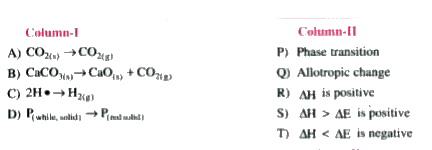Consider the following data:
ΔfH2(N2H4,l)=50kJ/mol,,ΔfH∘(NH3,g)=−46kJ/mol, B.E. (N−H)=393kJ/molandB.E.(H−H)= 436 kJ/mol, also ΔvapH(N2H4,l)=18kJ/mol. The N-N bond energy in N2H4 isSolution in Telugu
226 kJ/mol
154 kJ/mol
190 kJ/mol
45.45 k Cal/mole
The correct Answer is:C, D
N2+2H2→N2H4(l),ΔH1=50
12N2+32H2→NH3(g),ΔH2=−46
N2H(l)→N2H4(g),ΔH3=18––––––––––––––––––––––––––––––––––
N2H4(g)+H2→2NH3,ΔH
ΔH=−ΔH3+2ΔH2−ΔH1=−160
Theoretically, ΔH=((N−N)+4(N−H)+(H−H))−(2×3×(N−H))
⇒(N−N)=190 kJ/mol = 45.45 Kcal/mole
Topper's Solved these Questions
- BOOK - AAKASH SERIESCHAPTER - CHEMICAL THERMODYNAMICSEXERCISE - PRACTICE SHEET (EXERCISE- II) (LEVEL- II (ADVANCED) LINKED COMPREHENSION TYPE QUESTIONS)5videos
CHEMICAL THERMODYNAMICS
- BOOK - AAKASH SERIESCHAPTER - CHEMICAL THERMODYNAMICSEXERCISE - PRACTICE SHEET (EXERCISE- II) (LEVEL- II (ADVANCED) MATRIX MATCHING TYPE QUESTIONS)2videos
CHEMICAL THERMODYNAMICS
- BOOK - AAKASH SERIESCHAPTER - CHEMICAL THERMODYNAMICSEXERCISE - PRACTICE SHEET (EXERCISE- II) (LEVEL- II (ADVANCED) STRAIGHT OBJECTIVE TYPE QUESTIONS)4videos
CHEMICAL THERMODYNAMICS
- BOOK - AAKASH SERIESCHAPTER - CHEMICAL THERMODYANMICS EXERCISE - Questions For Descriptive Answers28videos
CHEMICAL THERMODYANMICS
- BOOK - AAKASH SERIESCHAPTER - ELECTRON MIGRATION EFFECTS EXERCISE - QUESTIONS FOR DESCRIPTIVE ANSWERS10videos
ELECTRON MIGRATION EFFECTS
Similar Questions
Enthalpy of neutralization is defined as the enthalpy change when 1 mole of acid/base is completely neutralized by base/acid in dilute solution. For strong acid and strong base neutralization net chemical change is H+(aq)+OH−(aq)→H2O(l),ΔH0r≡−55.84kJ/mol
If enthalpy of neutralization of CH3COOH by NaoH is -49.86 kJ/mol then enthalpy of ionisation of CH3COOH is06:02View SolutionMatch the following columns
 13:11View Solution
13:11View SolutionFor the real gases reaction 2CO(g)+O2(g)→2CO2(g),ΔH=−560kJ. In a 10L rigid vessel at 500K, the initial pressure is 70 bar and after reaction it becomes 40 bar. The change in internal energy is:
05:45View SolutionHow does heat of neutralisation value change with the chemical nature of acid and base?
View SolutionHyperconjugation effect is also termed as 'no bond resonance'. Why?
02:26View SolutionThe enthalpy change for the combustion of N_(2)H_(4)(l) (Hydrazine) is -622.2 kJ mol^(-1) . The products are N_(2)(g) and H_(2)O(l) . If Delta_(f)H^(Theta) for H_(2)O(l) is -285.8 kJ mol^(-1) . The Delta_(f)H^(Theta) for hydrazine is
07:48View SolutionCalculate the enthalpy of combustion of benzene (l) on the basis of the following data: a. Resonance energy of benzene (l) =- 152 kJ// mol b. Enthalpy of hydrogenation of cyclohexene (l) =- 119 kJ//mol c. Delta_(f)H^(Theta)C_(6)H_(12)(l) =- 156 kJ mol^(-1) d. Delta_(f)H^(Theta) of H_(2)O(l) =- 285.8 kJ mol^(-1) e. Delta_(f)H^(Theta)of CO_(2)(g) =- 393.5 kJ mol^(-1)
03:23View SolutionFind DeltaH of the process NaOH(s) rarr NaOH(g) Given: Delta_(diss)H^(Theta)of O_(2) = 151 kJ mol^(-1) Delta_(diss)H^(Theta) of H_(2) = 435 kJ mol^(-1) Delta_(diss)H^(Theta) of O-H = 465 kJ mol^(-1) Delta_(diss)H^(Theta) of Na -O = 255 kJ mol^(-1) Delta_(soln)H^(Theta)of NaOH = - 46 kJ mol^(-1) Delta_(f)H^(Theta) of NaOH(s) =- 427 kJ mol^(-1) Delta_("sub")H^(Theta) of Na(s) = 109 kJ mol^(-1)
02:49View SolutionFor the reaction N_(2)H_(4)(g)toN_(2)H_(2)(g)+H_(2)(g), DeltaH_("reaction")^(@)=109KJ//mol in_(N-N)=163KJ//mol in N-H=391KJ//mol in_(H-H)=KJ//mol then ,then bond dissocition energy of N=N is:
04:53View SolutionBased on the values of B.E. given, Delta_(f)H^(@) of N_(2)H_(4) (g) is : Given : N-N = 159 " kJ mol"^(-1)," "H-H=436 " kJ mol"^(-1) N-=N = 941" kJ mol"^(-1), " "N-H=398 " kJ mol"^(-1)
03:07View SolutionConsider the following data : Delta_(f)H^(@)(N_(2)H_(4),l)=50kJ//mol,Delta_(f)H^(@)(NH_(3),g)=-46kJ//mol B.E(N-H)=393" kJ//mol and B.E."(H-H)=436kJ//mol Delta_("vap")H(N_(2)H_(4),l)=18kJ//mol The N-N bond energy in N_(2)H_(4) is :
05:56View SolutionFor the reaction N_(2)H_(4) (g) rarr N_(2)H_(2)(g) +H_(2)(g)" "Delta_(r)H^(@)=109 KJ//mol Calculate the bond enthalpy of N=N . Given : B.E. (N-N) =163 KJ//mol, B.E. (N-H) =391 KJ//mol, B.E. (H-H)=436 KJ//mol
05:36View SolutionWith the help of a thermochemical equation, calculate Delta_(f)H^(@) at 298 K for the following reactions : "C(graphite)" + O_(2)(g) rarr CO_(2)(g) , Delta H = -393.5 kJ//mol H_(2)(g) + (1)/(2)O_(2)(g) rarr H_(2)O(l) , Delta_(f)H^(@) = -285.8 kJ//mol CO_(2)(g) + 2H_(2)O(l) rarr CH_(4)(g) + 2O_(2)(g) , Delta_(f)H^(@) = +890.3 kJ//mol
04:36View Solutionthe bond enthalpy of H_(2)(g) is 436 kJ "mol"^(-1) and that of N_(2)(g) is 941.3 kJ"mol"^(-1) . Calculate the average bond enthalpy of ann N-H bond in ammonia, Delta_(t)^(@)(NH_(3)) =-46 kJ "mol"^(-1)
04:08View SolutionUsing Delta_(f)H^(@) and S_(m)^(@) calculate the standard Gibbs energy of formation, Delta_(f)G^(@) for each following : (a) CS_(2)(l) (b) N_(2)H_(4)(l) Delta_(f)H^(@)(CS_(2)) = 89.70 kJ "mol"^(-1), Delta_(r)S^(@)(CS_(2)) = 151.34 J K^(-1) "mol"^(-1) Delta_(f)H^(@)(N_(2)H_(4)) = 50.63 kJ "mol"^(-1) , Delta_(r)S^(@)N_(2)H_(2) = 121.21 J K^(-1) "mol"^(-1) .
06:28View Solution

